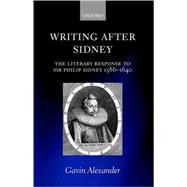
Writing after Sidney The Literary Response to Sir Philip Sidney 1586-1640
by Alexander, GavinBuy New
Rent Textbook
Rent Digital
Used Textbook
We're Sorry
Sold Out
How Marketplace Works:
- This item is offered by an independent seller and not shipped from our warehouse
- Item details like edition and cover design may differ from our description; see seller's comments before ordering.
- Sellers much confirm and ship within two business days; otherwise, the order will be cancelled and refunded.
- Marketplace purchases cannot be returned to eCampus.com. Contact the seller directly for inquiries; if no response within two days, contact customer service.
- Additional shipping costs apply to Marketplace purchases. Review shipping costs at checkout.
Summary
Author Biography
Gavin Alexander was educated at Leeds Grammar School and Gonville and Caius College, Cambridge, where he was subsequently a Research Fellow. He is currently a Lecturer in the Faculty of English, University of Cambridge, and Fellow, Librarian, and Director of Studies in English at Christ's College. He has published on various literary and musical topics, and is the editor of Sidney's The Defence of Poesy and Selected Renaissance Literary Criticism (Penguin, 2004).
Table of Contents
| List of Illustrations | p. xi |
| Note on Spelling, References, and Abbreviations | p. xiii |
| Introduction | p. xix |
| Dialogue and Incompletion: Philip Sidney | p. 1 |
| Elegies and Legacies | p. 56 |
| The Last Word: Mary Sidney, Countess of Pembroke | p. 76 |
| Families and Friends | p. 128 |
| Finding and Making: Robert Sidney | p. 149 |
| Lyric After Sidney | p. 193 |
| Life After Sidney: Fulke Greville | p. 220 |
| Versions of Arcadia | p. 262 |
| The Constant Art: Mary Wroth | p. 283 |
| Postscript | p. 332 |
| Bibliography | p. 339 |
| Index | p. 363 |
| Table of Contents provided by Ingram. All Rights Reserved. |
An electronic version of this book is available through VitalSource.
This book is viewable on PC, Mac, iPhone, iPad, iPod Touch, and most smartphones.
By purchasing, you will be able to view this book online, as well as download it, for the chosen number of days.
Digital License
You are licensing a digital product for a set duration. Durations are set forth in the product description, with "Lifetime" typically meaning five (5) years of online access and permanent download to a supported device. All licenses are non-transferable.
More details can be found here.
A downloadable version of this book is available through the eCampus Reader or compatible Adobe readers.
Applications are available on iOS, Android, PC, Mac, and Windows Mobile platforms.
Please view the compatibility matrix prior to purchase.
